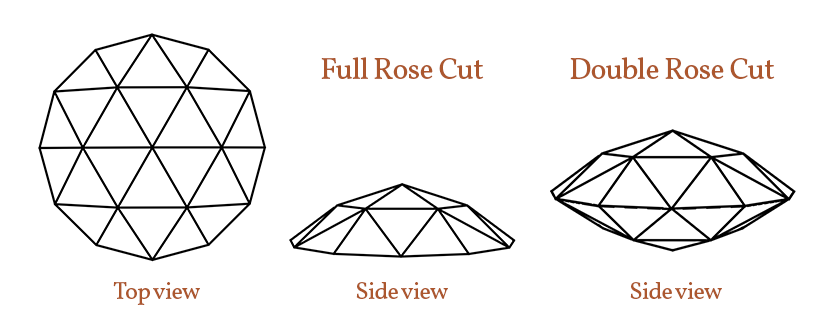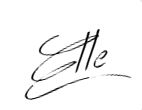I have a serious crush on rose cuts. But if you’ve been following any of my media for any period of time, you’ll have noticed this. There are rose cuts in two of my necklace designs, with the Ingenue being primarily based around the rose cut, they feature prominently in my Pétiller profile, and have even made an appearance in some of my custom designs. If they were easy to find, and I had unlimited funds, ALL OF THE ROSE CUTS WOULD BE MINE. Ok, so that’s not necessarily true, but I do love them, and I wish I could buy a lot more than I do.
So the reason I’m writing about this today is because I’m a bit neurotic. Recently a client of mine bought some “hexagon rose cuts”, and she asked me why when I said they weren’t rose cuts. So this is a bit of an analysis of what a rose cut is, using the hexagon diamonds as an example of how to discern what isn’t a rose cut, and what is just a fancy marketing gimmick.
A lot of what designates a rose cut is the intent of the cutter.
Did the cutter intend for it to be traditionally cut, and the stone wasn’t shaped well? Or did the cutter actually intend to cut a rose cut?
Facet Diagrams & Facet Structure
Rose cuts were often used as accent stones in antique jewelry. They have a simplistic cut that is a flattish dome, with triangular facets arranged in a hexagonal pattern, with a point on top. There is not a flat table facet on top of the stone, and there is no pavilion, the way Old European Cut or Modern Round Brilliants are cut. Rose cuts are typically round, but can be found in other shapes, such as pear, cushion, oval, etc.


Equiangular Hexagon
I am particularly strict in my evaluation of rose cut diamonds, and I insist that they have the equiangular triangled hexagon on top. Sometimes, especially with modern cut specialty shaped rose cuts, the hexagon will be elongated to mimic the outline of the stone. Like this modern cut pear:
It’s still a rose cut, but the facet structure is a clue that it’s not antique!
Lack of a Pavilion
It’s easy to get confused with terminology for rose cuts, since they don’t follow the same cutting guidelines as traditionally cut stones. I tend to think of them as a traditionally cut stone that has had the pavilion cut off at the girdle, but with a point on the table instead of the table being flat.
One of my very first gemstones was a peach spinel that had a rose cut table and crown, but with a traditional pavilion. Sometimes I miss that stone!
Faux Rose Cuts
Now, one of my biggest pet peeves has been popping up more and more lately and that’s taking a poorly, but traditionally cut stone (with a table, pavilion, culet, etc), flipping it over so it’s culet and pavilion face up with the table facing down, and calling that a rose cut. It is not a rose cut. You can determine these stones by looking at the facet structure, and seeing whether or not it is totally flat on the flat side, if it has a crown, and if the facets are almost equiangular AND triangular. Here is a helpful diagram to help illustrate the anatomy of a traditionally cut stone can look like.

You can see a comparison between the hexagonal traditional cut on the left, and the classic rose cut on the right. I can tell a few things from the hexagonal stone about the rough – the stone wasn’t deep enough to cut it to ideal specifications and have optimal light return when it’s table up. So in a clever marketing move, they flipped it over and marketed it as a “hexagonal rose cut”.
With these hexagonal stones, they were not originally intended to be rose cuts, and that is obvious once you take a closer look at the pavilion facets:
They have the equiangular center facets, but if you look closer, the facets that aren’t in the center are trapezoidal in shape, rather than triangular.
Interestingly, when I flip the stones over, and have the table/flat side up, you can see the huge difference, and clearly discern what the original intent of the cutter was. The hexagons show light return bouncing off the pavilions, minus the windowing in the middle, while the rose cut is essentially transparent:
Double Sided Rose Cut
Double sided rose cuts are very rare, and are often given different names, depending on the knowledge of the seller or owner. As you can see from the diagrams above, they are structured as if two rose cuts were put flat side against flat side.
Rose cuts come in all different flavors, and they’ve been enjoying a sort of resurgence into popularity with celebrity interest in them as well as antique jewelry coming back into fashion. You can expect to see more from me as well, but that is mostly due to my everlasting love for them, rather than following the trends!
Side note: Thanks to Jennifer Aniston for giving the rest of us some giant rose cut goodness to ogle when she’s out and about. (Yes, her engagement ring is a giant rose cut diamond!)








Leave a comment